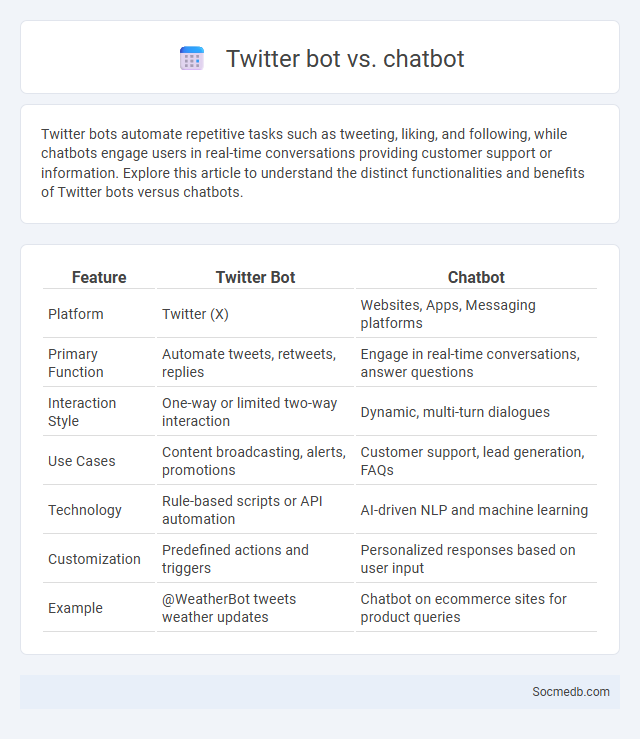
Photo illustration: Twitter Bot vs Chatbot
Twitter bots automate repetitive tasks such as tweeting, liking, and following, while chatbots engage users in real-time conversations providing customer support or information. Explore this article to understand the distinct functionalities and benefits of Twitter bots versus chatbots.
Table of Comparison
| Feature | Twitter Bot | Chatbot |
|---|---|---|
| Platform | Twitter (X) | Websites, Apps, Messaging platforms |
| Primary Function | Automate tweets, retweets, replies | Engage in real-time conversations, answer questions |
| Interaction Style | One-way or limited two-way interaction | Dynamic, multi-turn dialogues |
| Use Cases | Content broadcasting, alerts, promotions | Customer support, lead generation, FAQs |
| Technology | Rule-based scripts or API automation | AI-driven NLP and machine learning |
| Customization | Predefined actions and triggers | Personalized responses based on user input |
| Example | @WeatherBot tweets weather updates | Chatbot on ecommerce sites for product queries |
Introduction: Understanding Bots in the Digital Age
Bots in social media are automated software programs designed to interact with users and generate content, significantly influencing online engagement and information dissemination. These digital agents vary from harmless chatbots providing customer service to malicious entities spreading misinformation or manipulating public opinion. Recognizing the presence and impact of bots is essential for maintaining genuine interactions and safeguarding digital environments.
What is a Bot?
A bot is an automated software application designed to perform tasks on social media platforms, such as posting content, liking posts, or following accounts. These programs can quickly generate large volumes of activity, often mimicking human behavior to influence online engagement or spread information. Understanding how bots operate helps you identify authentic interactions and protect your social media presence.
Twitter Bots: Definition and Use Cases
Twitter bots are automated accounts programmed to perform tasks such as posting tweets, retweeting, liking content, or following other users to increase engagement and visibility. These bots serve various use cases including marketing automation, customer service responses, trend monitoring, and spreading information quickly across large audiences. Understanding how your Twitter bot operates can help enhance your social media strategy and ensure compliance with platform policies.
Chatbots: Functions and Applications
Chatbots in social media automate customer interactions through natural language processing, enabling 24/7 engagement and instant response to inquiries. They handle tasks such as personalized recommendations, appointment scheduling, and customer support, improving user experience and operational efficiency. Leading platforms like Facebook Messenger and WhatsApp integrate chatbots to streamline communication and enhance brand interaction metrics.
Key Differences: Twitter Bots vs Chatbots vs General Bots
Twitter bots automate interactions on the Twitter platform by posting, liking, or retweeting content based on pre-set rules or machine learning algorithms, primarily to influence social media engagement or trends. Chatbots simulate human conversations through messaging interfaces, offering personalized customer support, information retrieval, or interactive experiences tailored to Your queries. General bots encompass a broader category, including any automated software performing repetitive tasks across various digital environments, ranging from web crawlers to spam bots, with functionality extending far beyond social media or conversation.
Advantages and Limitations of Each Bot Type
Social media bots, such as chatbots, content bots, and follower bots, offer distinct advantages and limitations depending on their design and purpose. Chatbots enhance customer interaction by providing instant responses and personalized assistance but may struggle with complex queries, while content bots efficiently generate or curate posts but risk lowering authenticity. Follower bots can boost perceived popularity rapidly, yet they often violate platform policies and fail to engage genuinely with your audience.
Real-World Examples of Bots in Action
Bots on social media platforms like Twitter and Instagram manipulate conversations by amplifying trending topics, spreading misinformation, and creating fake follower networks. For instance, during the 2016 US presidential election, bot accounts significantly influenced public opinion by posting polarized content that appeared organic. These automated accounts generate thousands of interactions daily, skewing analytics and undermining genuine user engagement.
Ethical Considerations and Risks
Social media platforms present significant ethical considerations including user privacy, data security, and misinformation proliferation. Risks involve breaches of personal data, manipulation through targeted advertising, and the amplification of harmful content that can affect mental health. Implementing transparent policies and rigorous content moderation is essential for mitigating these challenges and fostering a responsible digital environment.
Future Trends in Bot Development
Future trends in social media bot development emphasize advanced natural language processing and AI-driven personalization to enhance user engagement and automate customer interactions more effectively. Bots will increasingly leverage real-time sentiment analysis and multi-platform integration, allowing Your brand to maintain consistent communication across diverse social media channels. Enhanced security protocols and ethical AI frameworks will also play a critical role in shaping the future landscape of social media bot deployment.
Choosing the Right Bot for Your Needs
Selecting the right social media bot depends on your specific goals, such as increasing engagement, automating customer service, or managing content scheduling. You should evaluate features like AI capabilities, integration with multiple platforms, and compliance with platform policies to ensure optimal performance. A bot tailored to your unique needs enhances efficiency, drives targeted interactions, and safeguards your account integrity.
 socmedb.com
socmedb.com